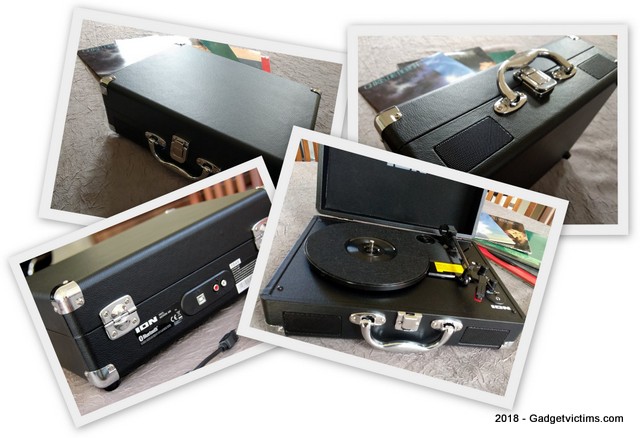
I had this project in mind for many years, but when the turntables made their comeback, most of them were overpriced due to the "novelty" effect.
Some decent turntables are now within the price limit I've fixed to myself, so it's time to give it a try ...
Choosing the right turntable
The choice of a turntable depends on the user profile and mine is quite simple:I have a small collection of old LP's (about 60) and only a half of them are worth digitizing.
After that, I'm unlikely to play them ever again. So I'm not going to spend much into a high-end player.
Because of its occasional use, I also want a compact turntable, that can be put away safe from dust once I'm done with it.
So an entry-level compact briefcase style turntable, below 100€, seems a good choice... for me.
 Nostalgic owners of valuable collectors who plan to play them on a regular basis fall outside this archive-and-forget category, and a higher budget (starting from 200€) for a real turntable is justified.
Nostalgic owners of valuable collectors who plan to play them on a regular basis fall outside this archive-and-forget category, and a higher budget (starting from 200€) for a real turntable is justified.Something with direct drive, anti-skating, stroboscopic speed tuning and counterweight from brands that have done it right for decades like Lenco, Pioneer or Sony.
So many briefcases!
They all look alike but some details can make the difference between the right and the bad choice.
Bluetooth OUT: those integrated speakers hardly rival with proper bluetooth speakers. Many turntables (1byone, Akai) have a Bluetooth IN instead, which means they can receive and play the music from an external source (PC, MP3 player, tablet, smartphone).
Battery: Some units come with a battery and it can be convenient to operate the device away from any power.
USB Flash drive connector or USB to PC:
Some models have a a USB Flash drive or SD Card port, allowing to record directly without the need of a computer.
I opted for a version with USB 2 Type B connector. While this requires a connection to a computer, it may allow more control over the recording operation that way. This is a personal choice. Unfortunately I haven't seen a model offering both options together.
Choosing between 2 very close rivals
GPO Ambassador (like GPO Attache but with battery)✓ Beautiful old-fashion style briefcase
✓ Direct to USB recording
✓ BT OUT
✓ Built-in battery
But...
I really wanted this one because of its beautiful old-fashion design, but, some user reviews kept me off: "Loud buzz heard over Bluetooth", "skips end of some 45rpm", "skipped...across the vinyl...for any record",
ION Vinyl Motion Air (like Vinyl Motion but with Bluetooth)
Highlights:
✓ USB to PC
✓ BT OUT
✓ Built-in battery
✓ Charging through USB (unlike the GPO which uses a dedicated connector)
Certainly not as stylish as the GPO models, but the reviews are unanimous on the ION overall quality.
So I made up my mind for this model.
It is also very affordable:
~80€ at Amazon.co.uk
Beware that many ships sell the non-Bluetooth for that price and there's no way to distinguish the 2 models if the model Vinyl Motion "Air" is not specifically specified.
Quick look at the ION Vinyl Motion Air
It's hard to tell from the picture but the ION turntable is light (less than 3Kg) and tiny (27.3 x 34.9 x 12.7 cm) which is good news for me as I wanted something compact for storing after use.
The Bluetooth works as designed. It can takes a while to pair with some Bluetooth receiver, and you'll know it's done when the blue LED stops blinking to turn on steady.
The output volume can be adjusted with the separate volume knob. Since there's always a delay between sound heard from the Bluetooth speakers and the embedded ones, the volume should be adjusted for only one source.
The turntable doesn't do auto-return but has an auto-stop. Since this is still a rudimentary equipment that may sometimes stop too soon on some vinyls, there's a switch to turn off that function.
This model uses a USB 2 Type B connector for both recharging the battery and to link with a computer for the recording. A USB cable and a charger are provided.
Archiving Vinyls

On the first connection to a PC, Windows will install the newly detected USB PnP Audio Device as a microphone.
The very first thing to do is to play a vinyl and go to the properties of that microphone to adjust the level. It's normal to lower it below 50 before getting a correct sound level.

ION provides the EZ Vinyl /Tape converter software for the archiving task.
The Windows version has some annoying limitations: It only records in WAV format, and it does not look up for the album and songs details on the Internet.
However it does split the tracks automatically and generally gives good results once the recording volume has been properly set.
Another free popular alternative is Audacity. This excellent sound editor will give you more control over your recording and a larger choice of formats to save them to.
Many functions are available to equalize, normalize, remove clicks and reduce noise from the recording.
Converting and tagging the tracks can be done with a music manager like MusicBee, a free music manager that I use for years to organize my digital music collection.
Its file converter can adjust the volume and organize the fly and the Auto-tagging utility can scan the tracks for a match with the online MP3 database. MediaMonkey offers similar functionalities but I never looked back once I adopted MusicBee.
There are all-in-one solutions, like the most popular VinylStudio (~25€) but I found that it requires at least the same amount of work to obtain the final result.















No comments:
Post a Comment
Note: Only a member of this blog may post a comment.